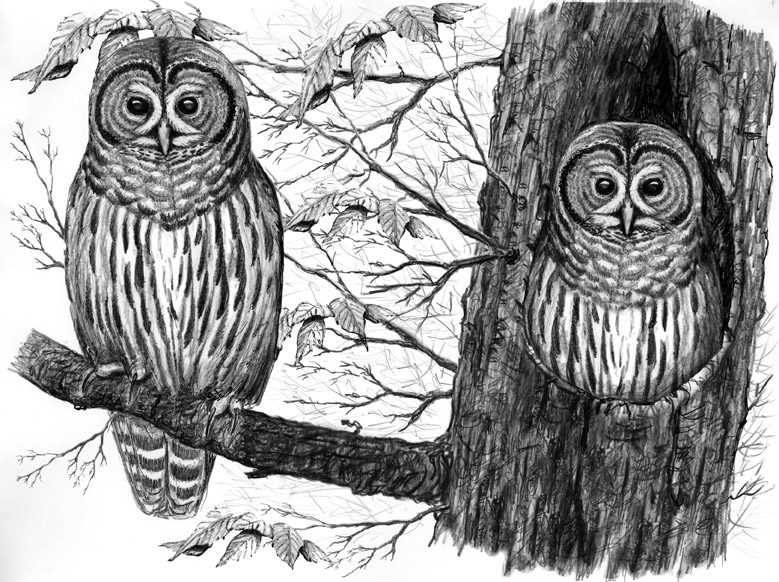
Dear Bird Folks,
Here are photos of four owls that we have been seeing in our backyard. I believe they are Barred Owls, but instead of hooting, they are making soft, high-pitched sounds. Are they, in fact, Barred Owls and do we often see them around here?
– Clare, Sandwich, MA
Not if it’s 2003, Clare,
Back on March 21, 2003 I wrote a column entitled: Barred Owls Not On Cape Cod. While I may not have a perfect track record for getting information 100% correct, that 2003 column was right on the button. At that time there were no Barred Owls breeding on Cape Cod and only rarely were they even heard on this side of the Canal. But many things have changed since then. For example, we can no longer buy a SAAB, shop at Bradlees or need to use dental floss. A few things have changed for the better, however, and we now have Barred Owls on Cape Cod (yay!), which makes my 2003 column as outdated as driving to Bradlees in a SAAB, to buy floss.
Unlike Great Horned Owls, which will nest just about anyplace, Barred Owls prefer deep woods and big trees, which are in short supply around here. As a result, Barred Owls, regularly seen in other parts of the state, have avoided the Cape like a politician avoids the truth. But that all changed in 2007 (four years after my column), when the mother and daughter team of Mary and Ashley Keleher discovered baby Barred Owls in the Mashpee River Woodlands. (I didn’t even know there was such a place. I have to get out more.) Since then, more and more Barred Owls are being heard calling on the Cape. For the most part, the reports have been from the Upper Cape (Falmouth, Sandwich, West Barnstable), where the trees tend to be bigger and badder. More recently, a Mid-Cape town (Harwich) has also been hearing Barred Owls. But alas, the Lower Cape continues to be Barred Owl-free. It appears no self-respecting Bared Owl wants to live in our scrawny trees…yet.
In addition to skinny trees, the other things Barred Owls tend to avoid are Great Horned Owls. Even though the two birds are roughly the same size, great horns are the Cape’s alpha avian hunters and will chow down Barred Owls faster than we order a pizza. But before you start feeling bad for the poor Barred Owls, don’t forget that they also are serious predators. They will capture and eat anything from rabbits, to foxes, to bats, to birds, including jays and cardinals, and if the price is right, fish.
Mass Audubon’s most recent breeding bird atlas lists Barred Owls as probable Cape nesters. They say “probable” because we have yet to find an active nest. Even though both you and the Kelehers have found baby owls, that apparently is not enough evidence for Mass Audubon, and I’m not sure why. How do they think the baby owls got here… on a bus tour? Oh well, I guess it’s our job to find a nest. And by “our job,” I mean your job, Clare. After all, the babies are in your yard. The last thing you want is someone like me walking through your yard with binoculars, especially at night. So, here is what to look for.
The first thing to do is look up. Barred Owl nests tend to be twenty to forty feet off the ground. Sometimes they will use old crow nests, but they prefer to lay their eggs in tree cavities. But unlike bluebirds, Barred Owls are much too large to fit in old woodpecker holes. Instead, they have to find a cavity that has been created in a tree (a large tree) by disease, a broken branch or a storm. Barred Owls have also been known to use man-made nest boxes. I thought about putting up one of those boxes in my yard, but then changed my mind. Climbing forty feet up a tree, while carrying a heavy birdhouse is a bit out of my comfort zone. I asked my wife if she’d put one up, but she didn’t want to do it either. What a wimp.
The next thing you should do is learn the Barred Owl’s call. In spite of what some people think, many of our owls don’t give a “hoot.” Instead of hooting, some owl species produce trills, or raspy barks or eerie hisses. But both Great Horned Owls and Barred Owls are big hooters…so to speak. Their hoots are long, loud and distinctive. The memory tool, or mnemonic, for the Barred Owl’s call is typically “who cooks for you?” That phrase seems to work for most folks, but I suggest you go online (or use a bird app) and listen to the calls yourself. Then, if you want, you can create your own mnemonic. And while you are at it, come up with a mnemonic for spelling “mnemonic.” What’s up with that word? *
The soft sounds produced by young Barred Owls are much different than the booming calls made by the adults. The sounds you have been hearing are the babies begging for food from their parents. Those soft sounds are in sharp contrast to the harsh, grating calls produced by Great Horned Owl fledglings. Their calls are just plain scary, sounding like a combination of a cat with laryngitis and Gollum falling into the fires of Mt. Doom.
Enjoy your baby owls, Clare. It’s too late to find their nest this year, but next winter, after the leaves are off the trees, you should start looking. Who knows, maybe you’ll get lucky and be the first person (as far as I know) to find an active Barred Owl nest on Cape Cod. How cool would that be?
*I know I’ve made that mnemonic joke before, but in an effort to “go green,” I’m doing more recycling. Just trying to do my part to save the planet.